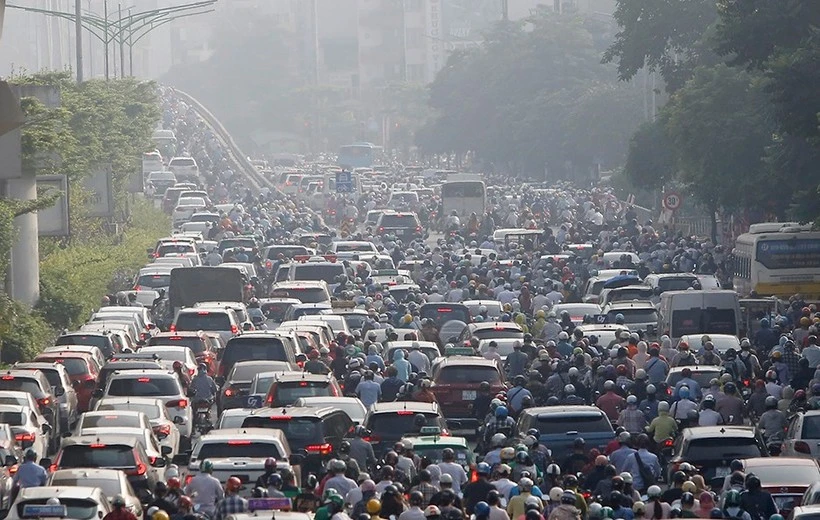China Air Quality Alert – IQAir

Air Quality Assessment in China: A Report on Public Health and Sustainable Development Goals
Executive Summary
This report details the severe air pollution event in eastern and southeastern China as of October 28, 2025. Air Quality Index (AQI) readings have reached “unhealthy” to “very unhealthy” levels, with dangerously high PM2.5 concentrations. This situation poses significant public health risks and highlights critical challenges in achieving key United Nations Sustainable Development Goals (SDGs), particularly SDG 3 (Good Health and Well-being), SDG 11 (Sustainable Cities and Communities), and SDG 7 (Affordable and Clean Energy).
Current Air Quality Status and Public Health Impact (SDG 3)
On October 28, 2025, major urban centers across eastern and southeastern China are experiencing poor air quality, directly threatening public health and undermining SDG 3, which aims to ensure healthy lives and promote well-being for all. The high concentration of PM2.5 pollutants presents acute health risks, especially for vulnerable populations such as children and the elderly.
Affected Urban Centers
Multiple cities have recorded AQI readings exceeding 200, a level classified as “very unhealthy.” Notable cities impacted include:
- Wuhan (ranked 5th most polluted major city globally)
- Beijing (ranked 7th most polluted major city globally)
Health Advisories and Protective Measures
In response to the hazardous conditions, public health warnings have been issued. To mitigate health risks in line with SDG Target 3.9 (substantially reduce the number of deaths and illnesses from hazardous chemicals and air, water and soil pollution), the following measures are advised:
- Limit outdoor activities.
- Keep windows and doors closed.
- Utilize high-efficiency air purifiers indoors.
- Wear protective masks when outdoors.
Annual Air Quality Assessment and SDG Benchmarks
While the current situation is acute, China’s annual air quality data also indicates a persistent challenge. In 2024, the nation’s average PM2.5 concentration was 31 µg/m³, corresponding to a “moderate” AQI of 90. This figure is 6.2 times higher than the World Health Organization’s annual guideline of 5 µg/m³. This persistent level of pollution places China among the 25 most polluted countries and signifies a failure to meet the objectives of SDG 11, Target 11.6, which calls for reducing the adverse per capita environmental impact of cities, including air quality.
Causal Factors of Air Pollution and SDG Linkages
The primary drivers of poor air quality, particularly during the winter season, are a combination of increased emissions and meteorological conditions. These factors are directly linked to challenges in energy, industry, and urban planning, reflecting core issues addressed by the SDGs.
Primary Emission Sources (SDG 7 & SDG 11)
The principal sources of pollutants are inconsistent with the goals of SDG 7 (Affordable and Clean Energy) and SDG 11 (Sustainable Cities and Communities).
- Residential Heating: Widespread use of coal and biomass for heating in northern regions releases significant amounts of particulate matter and sulfur dioxide (SO₂). A transition to cleaner energy sources is essential for achieving SDG 7.
- Industrial Emissions: Heavy industries, including power generation, steel, and cement manufacturing, remain major contributors to air pollution.
- Agricultural Practices: Open burning of biomass and straw in rural areas exacerbates regional air quality problems.
Meteorological and Atmospheric Conditions (SDG 13)
Atmospheric conditions play a crucial role in trapping pollutants, a phenomenon that may be influenced by broader climate patterns addressed in SDG 13 (Climate Action).
- Temperature Inversions: Common from October through February, winter temperature inversions trap cold, dense air and pollutants near the ground.
- Stagnant Weather: Weak winds and high humidity prevent the dispersal of pollutants and facilitate the formation of secondary aerosols, intensifying smog.
Outlook and Recommendations for SDG Alignment
Short-Term and Long-Term Projections
Short-term air quality improvements are contingent on favorable weather patterns, such as wind and rain, which can disperse pollutants. However, long-term, sustainable improvement requires systemic policy interventions. Recurring winter pollution episodes demonstrate that current strategies are insufficient to protect public health and achieve environmental sustainability.
Policy Recommendations for Sustainable Development
To achieve lasting improvements and align with the Sustainable Development Goals, a multi-faceted approach is required:
- Accelerate Clean Energy Transition (SDG 7): Invest in and expand the adoption of cleaner energy sources for residential heating and industrial power, reducing reliance on coal.
- Enforce Stricter Emission Controls (SDG 11): Implement and consistently enforce stringent emission standards for industrial facilities and vehicles.
- Develop Sustainable Urban Policies (SDG 11): Integrate air quality management into urban and regional planning to create healthier, more sustainable cities.
- Integrate Climate and Air Quality Policies (SDG 13): Recognize that measures to reduce air pollution, such as cutting fossil fuel combustion, also contribute to climate change mitigation.
Analysis of Sustainable Development Goals in the Article
1. Which SDGs are addressed or connected to the issues highlighted in the article?
The article on air quality in China addresses several interconnected Sustainable Development Goals (SDGs) by focusing on the environmental, health, and urban challenges posed by air pollution.
- SDG 3: Good Health and Well-being: The article directly connects poor air quality to public health, mentioning “serious health risks to residents, especially children and the elderly” and advising protective measures.
- SDG 11: Sustainable Cities and Communities: The core issue discussed is urban air pollution, with specific cities like Wuhan and Beijing being highlighted. The article focuses on the environmental quality within these major urban centers.
- SDG 7: Affordable and Clean Energy: The causes of pollution are linked to energy sources, specifically “Coal- and biomass-fired residential heating.” The proposed long-term solution is “cleaner energy adoption,” which is central to SDG 7.
2. What specific targets under those SDGs can be identified based on the article’s content?
Based on the issues and solutions presented, the following specific SDG targets are relevant:
-
Target 3.9: By 2030, substantially reduce the number of deaths and illnesses from hazardous chemicals and air, water and soil pollution and contamination.
- The article’s emphasis on “unhealthy” to “very unhealthy” air quality levels and the resulting “serious health risks” directly aligns with the goal of reducing illnesses caused by air pollution.
-
Target 11.6: By 2030, reduce the adverse per capita environmental impact of cities, including by paying special attention to air quality and municipal and other waste management.
- The article is entirely focused on this target, detailing the poor air quality in major Chinese cities and providing specific metrics like AQI readings and PM2.5 concentrations.
-
Target 7.2: By 2030, increase substantially the share of renewable energy in the global energy mix.
- This target is implied through the identification of the problem’s source (“Coal- and biomass-fired residential heating”) and the proposed solution (“cleaner energy adoption”). Reducing reliance on polluting fuels necessitates an increase in clean energy sources.
3. Are there any indicators mentioned or implied in the article that can be used to measure progress towards the identified targets?
Yes, the article mentions several specific quantitative and qualitative indicators that can be used to track progress.
- Annual mean levels of fine particulate matter (PM2.5): This is a direct indicator for Target 11.6 and is explicitly mentioned. The article states, “China’s average PM2.5 concentration in 2024 was 31 µg/m3,” and compares it to the “WHO annual guideline of 5 µg/m3.” This provides a clear, measurable metric of air pollution.
- Air Quality Index (AQI) readings: The article notes that “Several urban centers have recorded AQI readings above 200.” The AQI is a widely used indicator for communicating the level of air pollution and its associated health risks to the public, relevant to both Target 3.9 and 11.6.
- Reliance on polluting energy sources: The article identifies “Coal- and biomass-fired residential heating” and emissions from “Industrial sectors such as power plants, steel, cement, and chemical facilities” as primary causes. The proportion of energy derived from these sources versus cleaner alternatives serves as an implied indicator for Target 7.2.
- Implementation of emission control policies: The call for “stricter emission controls” and “effective seasonal policies” suggests that the existence, stringency, and enforcement of such regulations are key qualitative indicators. The article notes that “inconsistent enforcement” is a challenge, highlighting this as a crucial area for measurement.
4. Summary Table of SDGs, Targets, and Indicators
| SDGs | Targets | Indicators Identified in the Article |
|---|---|---|
| SDG 3: Good Health and Well-being | 3.9: Reduce deaths and illnesses from air pollution. |
|
| SDG 11: Sustainable Cities and Communities | 11.6: Reduce the adverse per capita environmental impact of cities, focusing on air quality. |
|
| SDG 7: Affordable and Clean Energy | 7.2: Increase the share of renewable energy. |
|
Source: iqair.com
What is Your Reaction?
 Like
0
Like
0
 Dislike
0
Dislike
0
 Love
0
Love
0
 Funny
0
Funny
0
 Angry
0
Angry
0
 Sad
0
Sad
0
 Wow
0
Wow
0
















































:focal(1500,1000)/https://media.globalcitizen.org/a6/9a/a69a4720-d8a1-4715-b596-18738d03c05c/rotary_polio_hero_image.jpg?#)







/countries/sri-lanka/photo-credit---dmc-sri-lanka.tmb-1200v.jpg?sfvrsn=dc298bcc_1#)

















